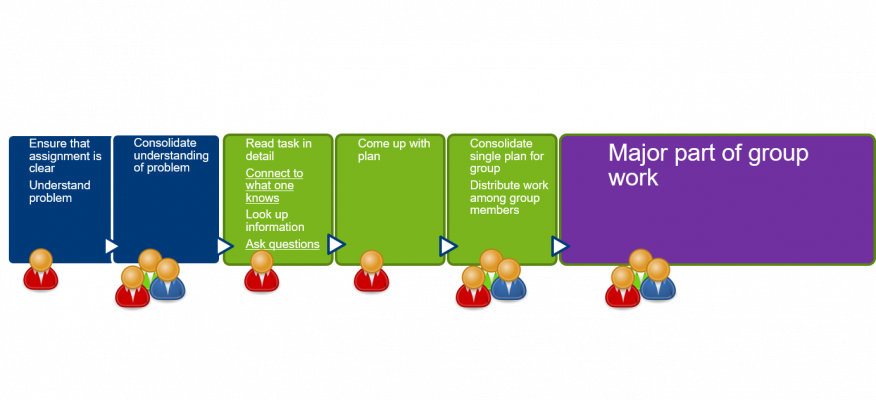(lemma in bold) |
(Changed categories.) |
||
| Line 41: | Line 41: | ||
[[Category:Decoding work]] | [[Category:Decoding work]] | ||
[[Category:Cross-disciplinary]] | [[Category:Cross-disciplinary]] | ||
[[Category:Bottleneck]] | |||
Revision as of 16:31, 15 July 2024
Group activities are an integral part of teaching. Often they consist of tasks given to students in order to work on them collectively. However, it cannot be assumed that students consciously or subconsciously perform operations that allow them to get started with problem solving in group tasks.
There are at least two issues here. One is generic and related to bottlenecks which appertain to group work.The second one is indirect: Instructors often use group activities as a means to help student overcome difficulties related to subject matter, implicitly assuming that group work as a format is free of its own bottlenecks. If this assumption does not hold, however, the teaching format might backfire and hinder to achieve the intended teaching goal.
Decoding work done
Identification of bottleneck
In group activities many students are not effectively working as groups and don't know how to do so.
The instructor interviewed observed that at the beginning of in class group activities many of his students are "falling in some kind of hibernation"[1]. Students' difficulties related to group work seem to be at least in part beyond social and psychological interactions among the members of the groups which seem to be at the focus of most research on group work.[2]
Description of mental tasks needed to overcome the bottleneck
Being asked to envisage what the interviewed instructor would do in a group activity - being a member of a group of people like him - he progressively outlined a sequence of consecutive phases that commences group work:[1]
- Individually ensure the assignment is clear to oneself; come up with an initial understanding of the problem at hand; explore possible connections to subject matter.
- An initial coming together as a group “to clarify certain things about the problem”.
- Individually reading and further understanding the problem, identifying tasks and connecting it to what one knows and to the context of the course; looking up information and asking questions as necessary.
- Individually coming up with a plan of “how to attack the problem”.
- Drawing individual plans together in the group; consolidating a single plan for the group; distributing work among group members.
Note that it is not before phase 5 that individuals would considerably function as members of a group. Also note that phases 1 and 3 relate to the individual and not to the group as a whole.
In the course of the interview the instructor realized that the sequence he had laid out is focusing on problem solving and that it is related to that formulated by Pólya[3] in the context of mathematics.
Modelling the tasks
The interviewed instructor developed several metaphors to illustrate his thoughts to the interviewers. These might serve well to illustrate to students what is expected from them and what is necessary to engage successfully in activities.
Sharing
PublishedWork:Decoding_group_activities_in_interactive_teaching
Researchers involved
Stefan Dröschler, Peter Riegler, David Pace
Available resources
Transcript of decoding interview
Notes
- ↑ 1.0 1.1 Dröschler, Stefan; Riegler, Peter; Pace, David (2017). Decoding group activities in interactive teaching in K. Mårtensson et al. (eds.): Transforming patterns through the scholarschip of teaching and learning
- ↑ Smith, K. A. (1996). "Cooperative Learning: Making 'Group work' Work" In Sutherland, T. E., and Bonwell, C. C. (Eds.), Using active learning in college classes: A range of options for faculty, New Directions for Teaching and Learning No. 67.
- ↑ Pólya, G. (1957). How to solve it. The classic introduction to mathematical problem solving. London: Penguin
References
PublishedWork:Decoding_group_activities_in_interactive_teaching
